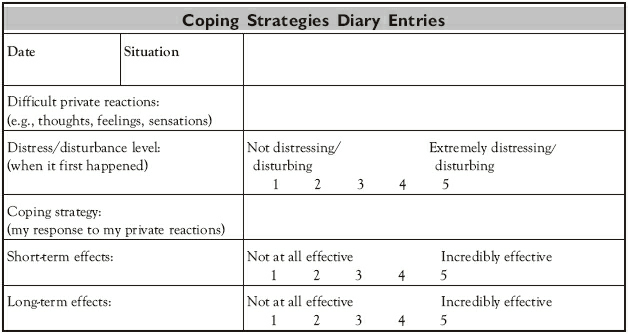 What is the human mind? Why are we different than the birds flying outside our windows? And why do we suffer so? These kinds of questions have puzzled humankind for eons. Here are a couple of ideas that might help as you work with your own suffering in therapy.
What is the human mind? Why are we different than the birds flying outside our windows? And why do we suffer so? These kinds of questions have puzzled humankind for eons. Here are a couple of ideas that might help as you work with your own suffering in therapy.
THE NATURE OF HUMAN LANGUAGE
The beauty of human language and cognition is that it allows us to learn without requiring direct experience. For example, a cat won’t touch a hot stove twice, but it needs to touch it at least once to get the hint. A human child need never touch a hot stove to be taught verbally that it can burn. In the outside world, this ability is a tool beyond compare. But in terms of our inner lives, verbal rules can restrict our lives in fundamental ways.
We all think relationally, which is to say that our brains are able to arbitrarily relate objects in our environment, thoughts, feelings, behavioral predispositions, actions (basically anything) to other objects in our environment, thoughts, feelings (basically anything else) in virtually any possible way (e.g., same as, similar to, better than, opposite of, part of, cause of, and so on).
This characteristic is essential to the way the human mind functions because it is our key evolutionary asset and has permitted the human species a dominant role in the animal kingdom. The ability to think relationally allows us to consciously analyze our environment, develop tools, build fires, create art, make computers, and even do our taxes. BUT, this same ability creates suffering.
SYM-BOLLOCKS
 Our minds work symbolically. The word “symbol,” comes from an ancient Greek root, “bol,” which means “to throw.” Combined with “sym” (which means “the same”), a symbol literally means “thrown as the same.” When our minds throw words at us, those words appear to be much the same as the things to which they refer. Which is why if I use the word BOLLOCKS in my punning title, your mind can’t help but see me throwing a slur on something, as well as maybe finding a pair of crude graffiti testicles surfacing in your imagination, or some other form of other mental chatter. Whatever your mind is telling you about the above title is just a story about a word that doesn’t even exist. Maybe the person writing this (me), just wanted to grab your attention through his dense exposition. But once our minds get hold of language and start relating it to other things, who knows where they might go!
Our minds work symbolically. The word “symbol,” comes from an ancient Greek root, “bol,” which means “to throw.” Combined with “sym” (which means “the same”), a symbol literally means “thrown as the same.” When our minds throw words at us, those words appear to be much the same as the things to which they refer. Which is why if I use the word BOLLOCKS in my punning title, your mind can’t help but see me throwing a slur on something, as well as maybe finding a pair of crude graffiti testicles surfacing in your imagination, or some other form of other mental chatter. Whatever your mind is telling you about the above title is just a story about a word that doesn’t even exist. Maybe the person writing this (me), just wanted to grab your attention through his dense exposition. But once our minds get hold of language and start relating it to other things, who knows where they might go!
This is because when we think, we arbitrarily relate events. Symbols “carry back” objects and events because they are related to these events as being “the same.” These symbols enter into a vast relational network that our mind generates and expands on over the course of our lives.
You can test this idea out by trying the following exercise.
Exercise: Relating Anything to Anything Else
Write down a concrete noun here (any type of object or animal will do).
Now write another concrete noun.
Now answer this question: How is the first noun like the second one? When you have a good answer, go on to this next question: How is the first noun better than the second one? When you have a good answer, go on to this question: How is the first one the parent of the second one? Finding an answer to this final question may not be straightforward. Stick with it. It will come.
That last question may have been the hardest, but if you do stick with it, you will always find an answer. And note that the good answers somehow seem to be “real” in the sense that the relation you see seems to be actually in or justified by the related objects (that is, they often seem to be not arbitrary at all).
This exercise demonstrates that the mind can relate anything to anything in any possible way. In technical terms it suggests that relational responding is “arbitrarily applicable.” This fact is hidden from view because the mind justifies these relations by features it abstracts from the related facts. As you can see from this silly exercise, that cannot be wholly true. It cannot be that, in fact, everything actually can be “the parent of” everything else. Yet your mind can always find a justification for that relation or any other.
This seems so obvious that it may seem unimportant. But research suggests this process is at the very core not only of how humans think, but why they suffer.
This is one reason that even beautiful sunsets may not be safe for human beings in pain (what we sometimes call when referring to ourselves or others anxious-depressed human beings). You’re watching a beautiful sunset, maybe drinking a beer, and feeling really good. And then the next moment, your mind says something like: “Ah, but wouldn’t it be nice if [Special Person Who Once Was In Your Life But Now Isn’t] were here to enjoy the sunset with me!” And the next thing you know it, you’re sad. If “happy” is the opposite of “sad,” then happiness can remind human beings of being sad. The two are related. This is probably part of the reason that relaxation can also induce panic, and other strange quirks of the human brain. Dogs do not know how to do this. People do.
WHERE LANGUAGE WORKS FOR US
 As best we can tell, the ability to derive relations like this is probably only about 75,000 to 100,000 years old, and in highly elaborated forms it is much younger than that. Written language marks a real transition in the ability to relate events in this way and it is only five- to ten-thousand-years old, depending on what you count as written symbols. By animal standards, humans are frail, slow-moving creatures. We do not have the strength of gorillas, the teeth of tigers, the speed of cheetahs, or the venom of snakes. Nevertheless, over the last 10,000 years we have taken over the planet. Why is that? There’s a strong chance that it’s got something to do with our abilities to use language.
As best we can tell, the ability to derive relations like this is probably only about 75,000 to 100,000 years old, and in highly elaborated forms it is much younger than that. Written language marks a real transition in the ability to relate events in this way and it is only five- to ten-thousand-years old, depending on what you count as written symbols. By animal standards, humans are frail, slow-moving creatures. We do not have the strength of gorillas, the teeth of tigers, the speed of cheetahs, or the venom of snakes. Nevertheless, over the last 10,000 years we have taken over the planet. Why is that? There’s a strong chance that it’s got something to do with our abilities to use language.
Here’s an interesting exercise that will help to illustrate this point.
EXERCISE: A Screw, a Toothbrush, and a Lighter
Consider this simple problem. Watch carefully what your mind does with it.
Suppose you have a slotted screw in a board and you want to get it out. You can use only a normal toothbrush and a cigarette lighter to do so. What will you do? Take a moment to think about it and write down your thoughts, even if they are fragmentary:
If nothing comes to mind yet, remember that the toothbrush is plastic (watch carefully what your mind does now, and write down your thoughts, even if fragmentary):
If nothing comes to mind yet, remember that plastic is made from oil. Now write down any thoughts, even if fragmentary:
If nothing comes to mind that would work yet, remember that plastic can melt (watch carefully what your mind does now):
If nothing comes to mind yet, remember that when melted, plastic is pliable. Now write down any thoughts this fact evokes:
If nothing comes to mind yet, remember that pliable plastic can form a shape (watch carefully what your mind does now):
If nothing comes to mind yet, remember that melted plastic hardens when cooled. Write down your ideas for removing the screw using only a toothbrush and lighter.
Hopefully, by now, you should be able to remove the screw, if it’s not screwed in too tightly and the melted plastic holds. (Presumably the plastic was melted by heating the end of the toothbrush with the lighter and inserting it into the screw while it was still pliable. Then waiting for the plastic to cool.) Now look at what you thought and wrote down.
Notice whether your thoughts had these qualities: you named objects and noted their properties; you described temporal (time-oriented) and contingent relations (if I did this, then…); and you evaluated or compared anticipated outcomes. See if it’s true that sometimes you literally “pictured” your ideas. That is, you saw the toothbrush, or pictured melting its handle at the end.
By doing this exercise, you’ve just demonstrated the main reason why humans, for good or for ill, have become the dominant species on the planet. These following relations are necessary for any verbal problem solving:
- EVENTS AND THEIR ATTRIBUTES
- TIME and/or CONTIGENCY
- EVALUATION
With these three sets of simple verbal relations we can think about the future, make plans, and evaluate and compare outcomes.
Unfortunately, with just these three sets (and not the scores of additional relations that language contains) you also have the capability to cause mental distress. Simply by having names for events and their attributes you can do a better job of remembering and thinking about them. You can, for example, remember and describe a past trauma and start sobbing as a result. You can be afraid of knives because you know they can cut and injure you (even if you’ve never seen that happen or had it happen to you).
With an if…then, or a temporal relation, you can predict bad events that may not happen, you can be afraid that pain or depression will return in the future, or you can know that you will die and you can worry about that imagined future. As a result of these symbolic temporal relations, most people tend to live more in the verbally remembered past and the verbally imagined future than in the present moment.
With comparative and evaluative relations we can compare ourselves to an ideal and find ourselves wanting, even though we are actually doing quite well. We can think we are much worse than others, or (perhaps just as bad) that we are much better than others. We can be afraid of negative evaluations from others, even if we haven’t ever experienced them, and we can become socially inhibited as a result.
These processes are quite primitive. Consider what a six-year-old child is like and then read this sad news story:
On Dec. 27, 2014, Kendrea was found hanging by a jump rope, tied to her bunk bed railing in her foster home in Brooklyn Park, Minnesota. She was later pronounced dead. Found in her room were notes written on torn pages from a children’s book. “I’m sorry for going in your room,” the notes said. “I’m sad for what I do.”
Suicide is unknown among two-year-olds, but just a few years later, when we are able to think about the future and evaluate what we imagine, we have the tools to imagine we would be better off dead. If a six-year-old can hang herself because her mind has grabbed onto a telling-off from a foster parent for going into their room, turning it into a suffering “mental stick” by which to beat herself, a person as complex as you are has all of the cognitive tools needed to be tormented. And act on them!
Main take-away: humans suffer, in part, because they are verbal creatures. If this is so, then here is the problem: the verbal skills that create misery are too useful and central to human functioning to ever stop operating. That means suffering is an unavoidable part of the human condition, at least until we know how to better manage the skills language itself has given us.
WHY LANGUAGE CREATES SUFFERING
 In normal problem-solving situations, when there is something we don’t like, we figure out how to get rid of it and we take actions to do that. If we don’t like dirt on the floor, we get out the vacuum cleaner. If we don’t like a leaky roof, we fix it. The human approach to solving problems can be stated as, “If you don’t like something, figure out how get rid of it, and then get rid of it.” That’s exactly why the linguistic and cognitive processes we’ve just described are useful. But when we apply this strategy to our own inner suffering, it often backfires.
In normal problem-solving situations, when there is something we don’t like, we figure out how to get rid of it and we take actions to do that. If we don’t like dirt on the floor, we get out the vacuum cleaner. If we don’t like a leaky roof, we fix it. The human approach to solving problems can be stated as, “If you don’t like something, figure out how get rid of it, and then get rid of it.” That’s exactly why the linguistic and cognitive processes we’ve just described are useful. But when we apply this strategy to our own inner suffering, it often backfires.
SUPPRESSING YOUR THOUGHTS
Suppose you have a thought you don’t like. You’ll apply your verbal problem-solving strategies to it. For example, when the thought comes up, you may try to stop thinking it. There is extensive literature on what is likely to happen as a result. Harvard psychologist Dan Wegner has shown that the frequency of the thought that you try not to think may go down for a short while, but it soon appears more often than ever. The thought becomes even more central to your thinking, and it is even more likely to evoke a response. Thought suppression only makes the situation worse.
EXERCISE: A Yellow Camper Van
Let’s try an experiment and see whether suppressing a thought can work.
Get a clear picture in your mind of a bright yellow Camper Van. How many times during the last few days have you thought of a bright yellow Camper Van? Not that many, right?
Now get your watch out and spend a few minutes (five would be ideal) trying as hard as you can not to think even one single thought of a bright yellow Camper Van. Really try hard.
So how many times did you think of a bright yellow camper van however fleetingly, during the last few minutes while you were trying so hard not to think of it?
Now get your watch out and spend a few minutes (five would be ideal) allowing yourself to think whatever thoughts come to your mind. Return here when you are finished.
Write down how many times you had a thought about a bright yellow Camper Van, however fleetingly, during the last few minutes while you were allowing yourself to think of anything?
If you are like most people, the number of times you thought about a bright yellow Camper Van went up over time. You might have been able to keep the thought of a yellow Camper Van out of your mind while directly suppressing it, but sometimes even that breaks down, and the number of times such thoughts occur soars. Even if you were able to suppress the thought for a short period of time, at some point, you will no longer be able to do so. When this happens, the occurrence of the thought tends to go up dramatically. That is not simply because you were reminded of a yellow Camper Van. In controlled research studies, when participants are told about the Van, or Jeep, or Elephant but are not instructed to suppress thinking about it, the number of thoughts does not increase.
When you try not to think of something, you do that by creating this verbal rule: “Don’t think of x.” That rule contains x, so it will tend to evoke x, just as the words “BETTER THE DEVIL” can evoke a cartoon picture of Satan, but also a whole concept which your mind can either buy into or not.
Thus, when we suppress our thoughts, we not only must think of something else, we have to hold ourselves back from thinking about why we are doing that. If we check to see whether our efforts are working, we will remember what we are trying not to think and we will think it. The worrisome thought thus tends to grow.
If you have obsessive thoughts or worries, this pattern is probably familiar to you. Research has shown that the vast majority of people without obsessions have odd intrusive thoughts from time to time, just as people with obsessions do. What is the difference? Part of the answer to that question may be that those with severe obsessive thinking problems spend more effort on trying not to think these thoughts. If normal people are asked to not think certain thoughts, they too will begin to feel more distressed about their negative thoughts.
Now, let’s try this exercise again using one of the thoughts that contributes to your suffering.
EXERCISE: Don’t Think About Your Thoughts
Psychological problems of any kind become entangled with our thoughts, and as a result, if you are struggling psychologically, you probably also have recurring thoughts that cause you pain. For example, if you are depressed, you may have the thought, “I’m worthless and no one loves me” or even just “When will this depression go away?” If you are suffering from generalized anxiety disorder, you may have the thought, “Vigilance is the only way to be safe.” Now, try to isolate a single thought that contributes to your current suffering. You can use the examples above as models. If you can, deconstruct your thought until you have it in the form of a short sentence or simple phrase. When you have this sentence or phrase in mind, complete the exercise.
- Write down a thought that contributes to your suffering.
- How many times have you had this thought in the last week? (If you don’t know exactly how many times, make an approximation.)
- Now, get out your watch again, and try as hard as you can not to think that thought for the next few minutes (again, five minutes would be ideal). Return here when you are finished.
- Write down the number of times you had your thought, however fleetingly, while you were trying not to think about it.
- Now, take another five minutes, and again allow yourself to think anything you want. Come back here when you are finished.
- How many times did you think your thought when you allowed yourself to think about anything at all?
As you began to try to suppress your thought, what was your experience? Did it become less heavy, less central, and less evocative? Or did it become more entangling, more important, and even more frequent? If your experience was more like the second description than the first, this exercise illustrated an important point. That is, it can be useless or even actively unhelpful to try to get rid of those thoughts you don’t like. In controlled research, this doesn’t always work the way it does with arbitrary thoughts like those about bright yellow Camper Vans. That may be because personally relevant negative thoughts are often already the target of chronic thought-suppression and those thoughts are already quite high in frequency.
WHAT IS TRUE FOR THOUGHTS ALSO WORKS WITH EMOTIONS
 This same process applies to emotions. If you try not to feel a bad feeling, such as pain, not only do you tend to feel it more intensely, but previously neutral events also become irritating. Any parent knows this. If the kids are irritating you by making too much noise and you are trying to ignore it, the noise just becomes more and more irritating and, eventually, even little annoyances can cause you to explode.
This same process applies to emotions. If you try not to feel a bad feeling, such as pain, not only do you tend to feel it more intensely, but previously neutral events also become irritating. Any parent knows this. If the kids are irritating you by making too much noise and you are trying to ignore it, the noise just becomes more and more irritating and, eventually, even little annoyances can cause you to explode.
Emotions link to thoughts in the same way. Research has shown that when you suppress thoughts in the presence of an emotion, eventually the emotion evokes the thought, and the suppression strategies evoke both the thought and the emotion.
For example, suppose you are feeling sad and you are trying not to think of a recent loss, such as the death of a friend. Perhaps you’ll listen to your favourite music to try to keep your mind off the friend who will no longer be in your life. What would be the result? Eventually, when you feel sad, you’ll be more likely to think of your loss, and your favourite music will tend to sadden you and remind you of your dead friend. In a sense you will have amplified your pain in your attempt to avoid feeling it. There doesn’t seem to be a way out of this thought/language trap.
BEHAVIOURAL PREDISPOSITIONS AND THE LANGUAGE TRAP
Finally, the same results apply to behavioral predispositions, behaviours that are programmed to the degree that the mere thought of them sets off a chain of bodily and psychological events that predispose us to behave in the programmed way.
If you have a fear of heights, this effect may be quite familiar to you. When you look over a ledge from a great height, you almost feel a pull as if some invisible force were causing you to be unsteady precisely when you wish that would not happen. If we can generalize from the literature on suppression, this effect is probably not just in your mind: your fear activates some of the muscles that move you toward the ledge, as well as those that move you away from it. As a result, you feel unsteady.
WHAT YOU’VE (AND I) HAVE BEEN DOING SO FAR TO DEAL WITH OUR SUFFERING THOUGHTS, IMAGES, SELF-TALK
 It’s likely you’ve been using a verbally guided “fix-it” mentality to find a solution for the causes of your suffering. If you’re reading this pages, it’s also likely that your attempts haven’t been entirely successful. The coping techniques you’ve developed to fix or counteract the pain you struggle with belong to the same class of language-based, problem-solving behaviours described in the exercises above.
It’s likely you’ve been using a verbally guided “fix-it” mentality to find a solution for the causes of your suffering. If you’re reading this pages, it’s also likely that your attempts haven’t been entirely successful. The coping techniques you’ve developed to fix or counteract the pain you struggle with belong to the same class of language-based, problem-solving behaviours described in the exercises above.
Let’s look at this a little more carefully. What kinds of actions do you take to suppress or otherwise reduce, diminish, control, or counteract your painful thoughts, feelings, and bodily sensations? Consider all the rituals you engage in as a means to keep yourself from feeling pain. These might be as extreme as incessant hand washing if you are suffering with OCD, or as simple as turning on the telly at night to numb yourself from the aftereffects of the irritation you felt on your way home from work. Your coping behaviors might include purely psychological behaviors like thought-suppression or rationalization. Or perhaps you engage in physical activities like obsessive exercise, habitual smoking, or even intentional self-harm, like cutting, to ameliorate your pain. Whatever you do (and we all do some of these things to a greater or lesser degree), you can explore them in the exercise below.
EXERCISE: Evaluating Your Coping Strategies
Have a look at this Google Doc of Coping Strategies, and then return here for directions on how to work with it. In the column on the left, first write down a painful thought or feeling. (This can be taken from the Suffering Inventory you generated after reading about the difference between Pain and Suffering. It can also be something entirely different if you have a more pressing thought or feeling that you would like to address right now.)
Then, in the second column, write down one strategy you’ve used to cope with this painful thoughts, feelings and beliefs about yourself and the world. Once you’ve done this, please rank your coping strategy for two sets of outcomes. The first asks you to rate how effective your coping strategy has been in the short-term. That is, how much immediate relief do you get from the behaviour? For the second ranking, rate your strategy for how effective it’s been in the long-term.
Think about how much of your total pain is caused by your painful thought or feeling. Has your coping behaviour reduced your pain over time? Rate each short- and long-term strategy on a scale from 1 to 5 where 1 is not effective at all and 5 is incredibly effective. For the time being, simply note your rankings. We will look at what they mean in greater detail in a later session.
For example, suppose someone writes a thought like this: “I’m not sure life is worth living” in the “Painful thought or feeling” column. The coping technique the person uses may be to have a beer, watch sports, and try not to think about it. While watching TV, the short-term effectiveness of the strategy may be ranked a 4; but later, the thoughts may be stronger than ever and the long-term effectiveness may be ranked a 1.
COPING STRATEGIES DIARY
If you find that you aren’t sure what you’ve been doing to cope, it may be best to collect this information first in diary form. You can create a form like the one below and use it to record what happens in your life when you experience something psychologically painful. Note the situation (what happened that evoked a difficult private experience); what your specific internal reactions were (particular thoughts, feelings, memories, or physical sensations); and the specific coping strategy you used then (e.g., distracting yourself, trying to argue your way out of your reactions, leaving the situation). After making entries like these in diary form for a period of one week, you should have a better understanding of what coping strategies you have been using and how effective they are.

THE PROBLEM WITH GETTING RID OF THINGS—SQUARED
There is another important reason that figuring out how to get rid of troublesome thoughts or feelings often backfires when your verbal skills are applied to your internal processes: it reminds you of bad consequences. Suppose you are feeling anxious while doing something challenging (say, giving a speech), and you think, “I’d better not feel anxious or I will completely fail at this.” Thoughts of failure can elicit anxiety for the same reason that a baby might be feel upset by hearing a nursery rhyme in C major (generally a pretty cheery chord) if it had been pricked with a nappy pin while Dad was listening to Wake Me Up, Before You Go Go the night before (also in C major): the negative consequence and current event are entirely arbitrarily related, but the suffering is real.
Anxiety is a normal response to poor performance, or humiliation. The problem is that we can bring these consequences into the current situation at any moment through verbal relations. People with panic disorder, for example, tend to think about losing their minds, losing control, humiliating themselves, or dying of a heart attack in association with the anxiety they feel. These thoughts create more anxiety partly because they relate the present to an imagined future in which there is the possibility of these dire results happening. If you have an anxiety condition, then you know that this can become a vicious circle.
EXPERIENTIAL AVOIDANCE
 Language creates suffering in part because it leads to experiential avoidance.Experiential avoidance is the process of trying to avoid your own experiences (thoughts, feelings, memories, bodily sensations, behavioral predispositions) even when doing so causes long-term behavioral difficulties (like not going to a party because you’re a social phobic, or not exercising because you feel too depressed to get out of bed). Of all the psychological processes known to science, experiential avoidance is one of the worst.
Language creates suffering in part because it leads to experiential avoidance.Experiential avoidance is the process of trying to avoid your own experiences (thoughts, feelings, memories, bodily sensations, behavioral predispositions) even when doing so causes long-term behavioral difficulties (like not going to a party because you’re a social phobic, or not exercising because you feel too depressed to get out of bed). Of all the psychological processes known to science, experiential avoidance is one of the worst.
Experiential avoidance tends to artificially amplify the “pain of presence” ((issues that are present that you would prefer to go away) , and it is the single biggest source of the “pain of absence”: the pain that results from us allowing our brains to dictate what kind of life we should be living, as opposed to the one we would really like to be living. It is avoidance that most undermines positive actions.
Outside the body, the rule may indeed be, “If you don’t like it, figure out how to get rid of it, and then get rid of it.” Inside the body, the rule appears to be very different. It’s more like, “If you aren’t willing to have it, you will.” In practical terms, this means for example, that if you aren’t willing to feel anxiety as a feeling, you will feel far more anxiety, plus you will begin to live a narrower and more constricted life.
Maybe have another look at your Coping Strategies Worksheet. If you are like most people, the majority of your coping strategies are focused on your internal processes. Usually, these coping strategies help to regulate your internal processes a little in the short run, but in the long run, they often fail or even make matters worse.
Now, consider the possibility that this is so because each of the coping strategies you’ve developed is a way to avoid your experiences. We develop specific means by which we try to stop feeling the feelings we are feeling or thinking the thoughts we are thinking. We try to avoid the experience of painful thoughts or feelings by burying ourselves in distracting activities, combating our thoughts with rationalizations, or trying to quash our feelings through the use of controlled substances. If we are suffering, we may spend a lot of time performing these distracting coping techniques. Meanwhile, our life is not being lived.
RANKINGS FOR COPING STRATEGIES
 In your review of your worksheet, you may have found that your scores in the “Short-term effectiveness” column are relatively high, while your scores in the “Long-term effectiveness” column are relatively low. This is a dangerous trap because short-term effects are far more reinforcing than long-term effects, and these problem-solving strategies do work in most areas of life for a short time. The coping techniques you’ve developed to combat your anger, anxiety, or depression probably do cause these feelings to go away for a short while; otherwise, you wouldn’t engage in them. But how powerful is the long-term effect? How much do your coping strategies really change your condition in the long run?
In your review of your worksheet, you may have found that your scores in the “Short-term effectiveness” column are relatively high, while your scores in the “Long-term effectiveness” column are relatively low. This is a dangerous trap because short-term effects are far more reinforcing than long-term effects, and these problem-solving strategies do work in most areas of life for a short time. The coping techniques you’ve developed to combat your anger, anxiety, or depression probably do cause these feelings to go away for a short while; otherwise, you wouldn’t engage in them. But how powerful is the long-term effect? How much do your coping strategies really change your condition in the long run?
If you’re reading this, I’m guessing that the long-term impact your strategies have had on your suffering is fairly minimal or even negative. What you are left with are behaviours that have become deeply embedded in your day-to-day life due to their short-term effectiveness; but for long-term relief they are sadly lacking.
Human beings have a core of pain because life inherently contains difficulties, such as disease, want, and loss, but language keeps us amplifying these difficulties into larger patterns of human suffering. Like the rings around a jagged rock thrown into a pool of suffering, we amplify that core of pain by our patterns of cognitive entanglement and avoidance.
WELCOME TO THE SHIT-STORM
When we try to run away from a painful thought, feeling, or bodily sensation, it becomes more important and tends to occur more intensely or frequently. Because running away also means that we are taking our fearful thoughts literally, they become more believable and entangling. As a result, the “pain of presence” grows. Meanwhile life is put on hold while we struggle with our internal processes. As a result, the “pain of absence” grows as well. The black spot in the middle of our lives, of pain and suffering, grows bigger and bigger. You can call this whatever you like, I like to call it a shit-storm. Because that’s how it feels.
RIDING THE MIND-TRAIN
 Unfortunately, these processes are not easy to control because they are so tightly linked to our normal use of language. People tend to “live in their minds,” that is, to engage with the world on the basis of these verbal processes. Living in your mind can be likened to riding a train. A train has its own tracks and it goes where they lead. That’s fine when the tracks are going where you want to go. But if you were traveling in the direction you want to be going, you probably would never have stopped to read this page. If the life you want to live is “off the tracks,” then you have only one option: you must learn how to get off the train and onto another track…at least sometimes.
Unfortunately, these processes are not easy to control because they are so tightly linked to our normal use of language. People tend to “live in their minds,” that is, to engage with the world on the basis of these verbal processes. Living in your mind can be likened to riding a train. A train has its own tracks and it goes where they lead. That’s fine when the tracks are going where you want to go. But if you were traveling in the direction you want to be going, you probably would never have stopped to read this page. If the life you want to live is “off the tracks,” then you have only one option: you must learn how to get off the train and onto another track…at least sometimes.
Riding our mind-trains is a totally automatic process. We believe the thoughts that our minds present to us. Getting the train going in the first place happened innocently enough: we learned language; we learned how to speak, reason, and solve problems. Once we did that, our mind-trains became a permanent presence in our lives. Now, there is no way that you will stop thinking and generating thoughts—your mind-train will keep on running, in part, because language is so useful in so many areas. But just because the train keeps running all the time doesn’t mean you have to stay on it every moment.
On a real train, you’re allowed to ride as long as you follow the rules. You play an active part on the trip. You’ve got to cooperate with the rules by showing your ticket when you’re asked for it, sitting in your assigned seat and staying seated, and not raising a ruckus when you miss your stop or you find out the train’s taking you in a direction you don’t want to go.
The rules and conditions our minds lay down for us are simple but powerful: act on the basis of belief and disbelief. They say that you must react to your mind either by agreeing with it or arguing with it. Unfortunately, both reactions are based on taking your thoughts literally. Rather than seeing your thoughts merely as an ongoing process of relating, they are reacted to based on what they relate to. They are “factually” correct or incorrect.
When we take our thoughts literally, we are “riding the mind-train.” That is, we are responding to the thoughts our mind presents to us purely in terms of the facts they are about. Agreeing and disagreeing are both within the rules, so neither response gets you off the train. However, if you break the rules, you will find yourself off the mind-train—and isn’t this one train you’d like to get off of now and then?
To know what an experience is really like, we’ve got to experience it for ourselves, not just think about it. To see what it’s like to jump off the mind-train, we have to actually do it. We do that by breaking some of the rules and conditions our minds have set for us. And how do we jump off that train? Well, that is precisely what certain forms of therapy like Acceptance and Commitment Therapy, DBT, CBT, Schema Therapy and IFS are all about: helping us to jump off the mind train when its no longer serving us and finding a better train to ride with a destination that is more meaningful to us than uncalled for suffering and despair. At this point, all I can say is that once you are off of the train with your feet on the ground, you will see whether you are in a better position to choose a direction and live according to your values rather than simply riding the rails of your verbal conditioning.
It will take a while to learn how to do this. But that’s the direction in which we are headed.
 In many ways, I love being the butt of someone’s joke, I love to be duped and fooled. Love magic tricks, especially of the Derren Brown variety that always reveal something profound to us about ourselves and others. As well as entertaining us in the process of fooling us.
In many ways, I love being the butt of someone’s joke, I love to be duped and fooled. Love magic tricks, especially of the Derren Brown variety that always reveal something profound to us about ourselves and others. As well as entertaining us in the process of fooling us.  But the ultimate April Fool is the fool our minds make of us on a daily basis. Never out of pure malice – for how can a lump of meat, the brain, sitting between our ears bear malice towards us? Rather, as a function of their problem-solving, pleasure-seeking, pain-avoiding programming. Every time my mind tells me that the reason so-and-so didn’t respond to my text message is because a) they don’t care about me or what I’ve written to them, or b) they don’t fundamentally like me, or whatever other narrative they come up with, and I buy into that and suffer. Again: April Fools y’all!
But the ultimate April Fool is the fool our minds make of us on a daily basis. Never out of pure malice – for how can a lump of meat, the brain, sitting between our ears bear malice towards us? Rather, as a function of their problem-solving, pleasure-seeking, pain-avoiding programming. Every time my mind tells me that the reason so-and-so didn’t respond to my text message is because a) they don’t care about me or what I’ve written to them, or b) they don’t fundamentally like me, or whatever other narrative they come up with, and I buy into that and suffer. Again: April Fools y’all!  My cynical/judgemental/critical brain sometimes can be a bit hard on kindness. “Hallmark card sentimentality,” it sneers. And I don’t argue with it when it says that. Yes, Dave, I say (I call that part of my brain, Dave), yes, that’s one way of looking at it, thank you.
My cynical/judgemental/critical brain sometimes can be a bit hard on kindness. “Hallmark card sentimentality,” it sneers. And I don’t argue with it when it says that. Yes, Dave, I say (I call that part of my brain, Dave), yes, that’s one way of looking at it, thank you. 

 What is the human mind? Why are we different than the birds flying outside our windows? And why do we suffer so? These kinds of questions have puzzled humankind for eons. Here are a couple of ideas that might help as you work with your own suffering in therapy.
What is the human mind? Why are we different than the birds flying outside our windows? And why do we suffer so? These kinds of questions have puzzled humankind for eons. Here are a couple of ideas that might help as you work with your own suffering in therapy.  Our minds work symbolically. The word “symbol,” comes from an ancient Greek root, “bol,” which means “to throw.” Combined with “sym” (which means “the same”), a symbol literally means “thrown as the same.” When our minds throw words at us, those words appear to be much the same as the things to which they refer. Which is why if I use the word BOLLOCKS in my punning title, your mind can’t help but see me throwing a slur on something, as well as maybe finding a pair of crude graffiti testicles surfacing in your imagination, or some other form of other mental chatter. Whatever your mind is telling you about the above title is just a story about a word that doesn’t even exist. Maybe the person writing this (me), just wanted to grab your attention through his dense exposition. But once our minds get hold of language and start relating it to other things, who knows where they might go!
Our minds work symbolically. The word “symbol,” comes from an ancient Greek root, “bol,” which means “to throw.” Combined with “sym” (which means “the same”), a symbol literally means “thrown as the same.” When our minds throw words at us, those words appear to be much the same as the things to which they refer. Which is why if I use the word BOLLOCKS in my punning title, your mind can’t help but see me throwing a slur on something, as well as maybe finding a pair of crude graffiti testicles surfacing in your imagination, or some other form of other mental chatter. Whatever your mind is telling you about the above title is just a story about a word that doesn’t even exist. Maybe the person writing this (me), just wanted to grab your attention through his dense exposition. But once our minds get hold of language and start relating it to other things, who knows where they might go! As best we can tell, the ability to derive relations like this is probably only about 75,000 to 100,000 years old, and in highly elaborated forms it is much younger than that. Written language marks a real transition in the ability to relate events in this way and it is only five- to ten-thousand-years old, depending on what you count as written symbols. By animal standards, humans are frail, slow-moving creatures. We do not have the strength of gorillas, the teeth of tigers, the speed of cheetahs, or the venom of snakes. Nevertheless, over the last 10,000 years we have taken over the planet. Why is that? There’s a strong chance that it’s got something to do with our abilities to use language.
As best we can tell, the ability to derive relations like this is probably only about 75,000 to 100,000 years old, and in highly elaborated forms it is much younger than that. Written language marks a real transition in the ability to relate events in this way and it is only five- to ten-thousand-years old, depending on what you count as written symbols. By animal standards, humans are frail, slow-moving creatures. We do not have the strength of gorillas, the teeth of tigers, the speed of cheetahs, or the venom of snakes. Nevertheless, over the last 10,000 years we have taken over the planet. Why is that? There’s a strong chance that it’s got something to do with our abilities to use language. In normal problem-solving situations, when there is something we don’t like, we figure out how to get rid of it and we take actions to do that. If we don’t like dirt on the floor, we get out the vacuum cleaner. If we don’t like a leaky roof, we fix it. The human approach to solving problems can be stated as,
In normal problem-solving situations, when there is something we don’t like, we figure out how to get rid of it and we take actions to do that. If we don’t like dirt on the floor, we get out the vacuum cleaner. If we don’t like a leaky roof, we fix it. The human approach to solving problems can be stated as,  This same process applies to emotions. If you try not to feel a bad feeling, such as pain, not only do you tend to feel it more intensely, but previously neutral events also become irritating. Any parent knows this. If the kids are irritating you by making too much noise and you are trying to ignore it, the noise just becomes more and more irritating and, eventually, even little annoyances can cause you to explode.
This same process applies to emotions. If you try not to feel a bad feeling, such as pain, not only do you tend to feel it more intensely, but previously neutral events also become irritating. Any parent knows this. If the kids are irritating you by making too much noise and you are trying to ignore it, the noise just becomes more and more irritating and, eventually, even little annoyances can cause you to explode. It’s likely you’ve been using a verbally guided “fix-it” mentality to find a solution for the causes of your suffering. If you’re reading this pages, it’s also likely that your attempts haven’t been entirely successful. The coping techniques you’ve developed to fix or counteract the pain you struggle with belong to the same class of language-based, problem-solving behaviours described in the exercises above.
It’s likely you’ve been using a verbally guided “fix-it” mentality to find a solution for the causes of your suffering. If you’re reading this pages, it’s also likely that your attempts haven’t been entirely successful. The coping techniques you’ve developed to fix or counteract the pain you struggle with belong to the same class of language-based, problem-solving behaviours described in the exercises above.
 Language creates suffering in part because it leads to experiential avoidance.Experiential avoidance is the process of trying to avoid your own experiences (thoughts, feelings, memories, bodily sensations, behavioral predispositions) even when doing so causes long-term behavioral difficulties (like not going to a party because you’re a social phobic, or not exercising because you feel too depressed to get out of bed). Of all the psychological processes known to science, experiential avoidance is one of the worst.
Language creates suffering in part because it leads to experiential avoidance.Experiential avoidance is the process of trying to avoid your own experiences (thoughts, feelings, memories, bodily sensations, behavioral predispositions) even when doing so causes long-term behavioral difficulties (like not going to a party because you’re a social phobic, or not exercising because you feel too depressed to get out of bed). Of all the psychological processes known to science, experiential avoidance is one of the worst. In your review of your worksheet, you may have found that your scores in the “Short-term effectiveness” column are relatively high, while your scores in the “Long-term effectiveness” column are relatively low. This is a dangerous trap because short-term effects are far more reinforcing than long-term effects, and these problem-solving strategies do work in most areas of life for a short time. The coping techniques you’ve developed to combat your anger, anxiety, or depression probably do cause these feelings to go away for a short while; otherwise, you wouldn’t engage in them. But how powerful is the long-term effect? How much do your coping strategies really change your condition in the long run?
In your review of your worksheet, you may have found that your scores in the “Short-term effectiveness” column are relatively high, while your scores in the “Long-term effectiveness” column are relatively low. This is a dangerous trap because short-term effects are far more reinforcing than long-term effects, and these problem-solving strategies do work in most areas of life for a short time. The coping techniques you’ve developed to combat your anger, anxiety, or depression probably do cause these feelings to go away for a short while; otherwise, you wouldn’t engage in them. But how powerful is the long-term effect? How much do your coping strategies really change your condition in the long run? Unfortunately, these processes are not easy to control because they are so tightly linked to our normal use of language. People tend to “live in their minds,” that is, to engage with the world on the basis of these verbal processes. Living in your mind can be likened to riding a train. A train has its own tracks and it goes where they lead. That’s fine when the tracks are going where you want to go. But if you were traveling in the direction you want to be going, you probably would never have stopped to read this page. If the life you want to live is “off the tracks,” then you have only one option: you must learn how to get off the train and onto another track…at least sometimes.
Unfortunately, these processes are not easy to control because they are so tightly linked to our normal use of language. People tend to “live in their minds,” that is, to engage with the world on the basis of these verbal processes. Living in your mind can be likened to riding a train. A train has its own tracks and it goes where they lead. That’s fine when the tracks are going where you want to go. But if you were traveling in the direction you want to be going, you probably would never have stopped to read this page. If the life you want to live is “off the tracks,” then you have only one option: you must learn how to get off the train and onto another track…at least sometimes.